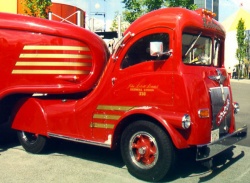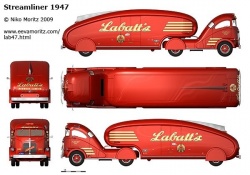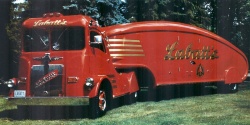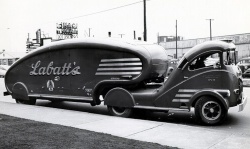Thursday, December 25, 2014
Monday, December 1, 2014
Monday, November 24, 2014
1961 Imports In U.S.A.

Sabra

Renault

Metropolitan


Toyopet Tiara

Triumph Herald

Vauxhall
Source: Oldcars
The Mars Express



One way to get to Mars in 1939.. The Mars Express. One way tickets only..
Source: oldcars
X-100 Continental Limousine

This is the X-100 Continental limousine as it was originally built. This photo was taken on 6-15-1961, just after it was delivered to the White House.

51 years later, the X-100 limousine on display at the Henry Ford Museum...
Tuesday, November 18, 2014
COE Trucks

1941 Chevrolet COE firetruck
1939 Ford COE Vehicle transporter 2
1959 Panhard Dyna Z
Gilmore Truck
Western Flyer 1941 motor home
1947 Streamliner By Alexis de Sakhnoffsky
| |||||
| |||||
|
Labatt's Streamliner
Streamlined beauty is on the road again

Labatt's restored Streamliner is touring Canada on its way to the winter Olympics
By TED LATURNUSAn article The Vancouver Sun on Friday, February 8, 2002If you were a beer drinking truck aficionado 50 or 60 years ago, you might have been lucky enough to see what some consider to be the most beautiful truck in the world. For almost 20 years - from 1936 to 1955 - the Labatt Streamliner was a common sight trundling around Canadian cities. It was especially welcome by those who have a taste for the barley sandwich, as it was used to haul beer from brewery to bar.
More than that, the Streamliner won a "Best Design" award at the 1939 World's Fair in New York and was the first tractor-trailer rig in Canada equipped with air brakes and an anti-jack-knifing device.
It was, by anyone's standards, an art nouveau masterpiece, guaranteed to stop truck drivers, beer drinkers, vintage car buffs, and just about anyone else in their tracks.
 |  |
| The sight of the Streamliner will revive memories for many Canadians. The truck has a wind-cheating shape and a high-gloss white oak and birch wood interior. | |
Constructed specifically for Labatt's, the Streamliner was also meant to give the company "instant identity" and "provide a viable alternative to rail." Originally co-built by the White Motor Company of Canada, Fruehauf Trailers and Smith Brothers Body Works, the first Streamliner delivered in 1935 - was the world's first truly aerodynamic truck. Only one survives - the bright red 1947 model pictured on this page - which, after a seven-year restoration project, was put back- on the road again in 1984. It is now touring Canada on its way to the winter Olympics, in Salt Lake City, Utah.
To get the Streamliner back to its original specs was far from straightforward. Despite the fact that the restorer, Joe Scott, posted a reward for any information leading to the recovery of a tractor unit, none surfaced. Nor were there any blueprints or diagrams available.
This meant the truck, frame, interior, and just about everything else had to be built from scratch. To come up with an authentic streamliner body, Scott downloaded photos of the original trucks into a computer and slowly put together a set of drawings.
The finished product is apparently accurate to within one-thirty-second of an inch. The trailer unit, surprisingly, was found almost intact in a field in Ontario, serving as an office for a construction company.
Because of its unique aerodynamic design, the Streamliner has a wooden body tub, with rolled aluminum sheathing tacked in place. Hundreds of individual pieces of wood were used in the body construction, as well as 30 different hammers to pound the metal into the right shape. The interior of the cab and trailer are finished in white oak and birch wood, and originally, beer was carried around in wooden barrels. The paint job consists of five coats of primer, five coats of bright red, and five more coats of clear-coat, with real gold leaf lettering.
Power is delivered by a White Mustang 386-cubic-inch in-line six-cylinder "flathead" gas-powered engine that develops 135 horsepower. It's mated to a five-speed transmission and a single reduction rear axle. It has air brakes front and back, and the cab is fitted with a hydraulic hoist that allows the driver to tilt it over for engine access. Empty, the Streamliner and trailer weigh 10 tons and can haul another 8.5 tons of cargo. Benny DiFranco, the Streamliner's manager and driver, says that it has a top speed of about 80 km/h (50 mph), which, for its day, made it quicker than just about everything else. What a concept: The fastest beer truck in the country.
I had an opportunity to drive the rig when it was in Vancouver this week and behind the wheel, it's more comfortable than you might think. The shift lever is a steel rod that juts out beside the driver's seat, and if you double clutch, the transmission is actually pretty civilized. There is no synchromesh, so when you slow down, you have to stop and start all over again in first. Power isn't exactly overwhelming, but the streamliner can keep up ... at least when it's empty. Just take the turns wide and be patient. I was actually surprised at how driveable the rig was ... not at all difficult.
In the 25 years I've been writing about cars and bikes, I've piloted some pretty wild and woolly creations. Everything from quarter million dollar luxury sedans to race-prepared sports cars to vintage flivvers to 300 km/h motorcycles. After driving the Labatt streamliner, I think I've about covered it.
Ted Laturnus is co-host of Driver's Seat, which airs Sundays on Global TV
Source: hankstruckpictures.com
Motoring Memories: The Labatt Streamliners, 1937-1947

 Labatt Streamliner; courtesy JustaCarGuy.blogspot.com. Click image to enlarge |
|
|
Although Prohibition ended in Ontario in 1927, beer advertising continued to be banned in the media. Brewers sought legal ways to keep their names in front of the public, and one of the most imaginative came from the Labatt Brewing Company of London, Ontario: Labatt’s “Streamliner” tractor-trailers.
In the 1930s, Labatt changed from shipping beer by rail to hauling beer by road. Needing a new fleet of large trucks, they decided to combine highway delivery with mobile advertising. They wanted more than the drab, rectangular haulers then in use so they conceived the Labatt Streamliner as a stylish rolling billboard.
Labatt turned to Count Alexis de Sakhnoffsky, a Russian-born Count who escaped to France following the revolution. After studying art and engineering he became art director for Belgian custom coach builder Van den Plas. He emigrated to the United States in 1928 to style everything from American Austins to supercharged Auburns.
Sakhnoffsky was engaged to design the Streamliner in 1935, and ultimately designed four generations. Although all were ahead of their time, the last one of 1947 was the most dramatic.
 Labatt Streamliner; courtesy JustaCarGuy.blogspot.com. Click image to enlarge |
Fifteen Streamliner bodies were completed in 1937 by Smith Brothers of Toronto out of hardwood and aluminum. Fruehauf produced the single-axle, low-bed trailers, and White Motor Co. supplied the tractor chassis. The futuristic Streamliner won the “Best Design” award at the 1939 New York World’s Fair.
The streamliners were the first Canadian tractor-trailers with an anti-jack-knifing device in the fifth wheel, and the first to use air brakes. Power came from a White “Mustang” 6.3-litre (386 cu in.), 135-horsepower six-cylinder engine driving through a five-speed transmission.
 1948 Labatt Streamliner; photo by Bill Vance. Click image to enlarge |
The Streamliner’s appearance was enhanced by a dramatic red paint treatment decorated with genuine gold leaf script. Labatt’s Highway Courtesy Program featured smartly uniformed drivers trained to assist in everything from flat tires to accidents. They generated positive publicity for Labatt on Ontario roads.
The last generation Streamliners were ordered by Labatt in 1941 but the Second World War delayed the first roll-out until 1947. In addition to the 10 Streamliners, there was a special order for one from Princess Julianna of The Netherlands, who stayed in Canada during the war. She admired the Streamliner so much she wanted one to transport her ponies!
 Labatt Streamliner; courtesy JustaCarGuy.blogspot.com. Click image to enlarge |
The Streamliners were retired in the mid-1950's, and gradually faded from memory. Then in 1977 Joe Scott of London, Ontario, along with Labatt, decided this piece of Canadiana should be preserved. Joe had recently retired from the presidency of White Truck Sales in London which serviced the Streamliners. With Labatt’s financial support, Joe and brother Bob, a long time Labatt employee, set out to find a 1947 Streamliner for restoration.
They eventually unearthed six trailers in Ontario. One was a construction field office, and although tatty, it was restorable.
The tractor was another matter. They wrote to every White branch in North America without success. A $500 finder’s reward generated wide publicity, but no tractor. Joe however, for some unexplained reason, was able to purchase a batch of fenders in The Netherlands. Perhaps Julianna had them in reserve.
The determined Scotts finally found two 1947 White cab-over trucks and set out to recreate the Streamliner tractor. Working from photographs and using a computer, blueprints were developed with accuracy within 1/32 of an inch (0.8 mm) of the original tractor’s dimensions and shape.
Using panel beating hammers and a metal-shaping wheeling machine, the aluminum cab was painstakingly recreated. The project was finally completed and the authentically restored 1947 Streamliner was on the road in 1983.
The Streamliner was honoured by appearing on a Canadian postage stamp in 1996. Owned by Labatt, the Streamliner is a roving goodwill ambassador that appears at fairs, exhibitions and other public events, To the delight of everyone, its horn doesn’t just toot, it plays “How dry I am.”
Source: autos.ca
Subscribe to:
Posts (Atom)





























